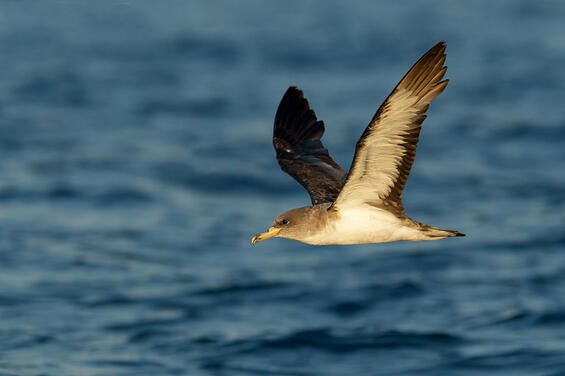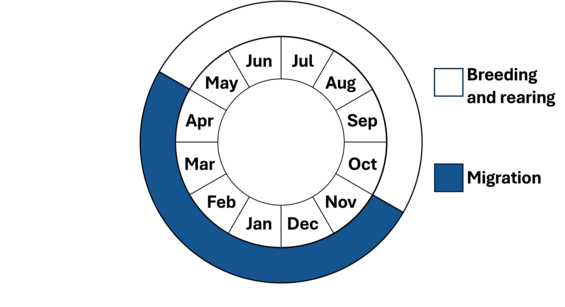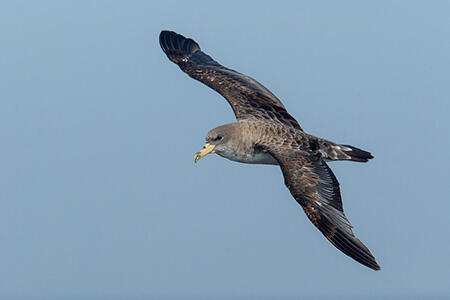- Scientific name: Calonectris borealis
- Species of Greatest Conservation Need (MA State Wildlife Action Plan)
Description

Cory’s shearwater (Calonectris borealis)
Cory’s shearwaters are large shearwaters (48-56 cm; 19-22 in long, mass 605-1,060 g; 1.3-2.3 lbs, and a wingspan on 113-124 cm; 44.5-48.8 in). They are a grayish brown above and white below, with pink feet and a relatively thick yellow bill. Shearwaters fly with characteristically stiff wing beats. Their name comes from the flight pattern of gliding along the troughs of waves and “shearing” the water.
Life cycle and behavior

Phenology in Massachusetts. This is a simplification of the annual life cycle. Timing exhibited by individuals in a population varies, so adjacent life stages generally overlap each other at their starts and ends.
Cory’s shearwaters are long-distant migratory seabirds that circumnavigate the Atlantic Ocean. They return to their eastern North Atlantic breeding colonies in starting in February and begin their breeding season in April. Cory’s shearwaters are primarily nocturnal during the breeding season and nest in burrows, rock crevices, and natural hollows or cracks. They typically lay a single egg. Egg laying is synchronous, occurring over 10 days in late May and early June. The incubation period is 52-56 days and both adults share incubation responsibilities. Incubation stint lengths vary depending on feeding ground proximity grounds but regularly last longer than 24 hours. Chick hatch begins in mid- to late July. Both parents provision chicks, with peak chick weights usually around 50 days old. As Procellariiformes, Cory’s shearwaters are adept fliers and may travel up to 2,000 km (~1250 mi) during a single foraging trip. Fledging occurs between 91-105 days, with juveniles preparing for fledge in October. Cory’s shearwaters winter in large numbers off the eastern coasts of North and South America and in the southwestern Indian Ocean. Immature birds return to their colonies after 2-3 years, but sexual maturity does not occur until at least seven years of age. Adult annual survival varies, but averages around 90%. While adult lifespans are unknown, birds that are at least 26 years old are recorded at the breeding colony.
Diets are varied and recorded prey groups include mackerel, flying fish, sea robins, and cephalopods. Cory’s shearwater capture prey through surface-seizing, shallow-plunging, pursuit-plunging, and pursuit-diving. They are commonly seen feeding in association with trawlers, large predatory fish, and marine mammals.
Population status
There were 504,000-507,000 mature individuals estimated in 2012. The current population trend is unknown. There are records of population recovery in the Maderia archipelago, but it is assumed that the population is not experiencing population-wide declines.
Distribution and abundance
Cory’s shearwaters are widespread throughout the North and South Atlantic Oceans and southwestern Indian Ocean. They are locally abundant, especially around their breeding colonies in the northeast Atlantic. There are recent instances of breeding colony expansion into previously unoccupied territories.
Habitat
Cory’s shearwaters breed on barren, offshore islands in northwestern Spain, the Berlengas Islands, Madeira, the Azores, and the Canary Islands. Outside of the breeding season, they are pelagic and keep offshore in temperature and sub-tropical marine systems. In Massachusetts, Cory’s shearwaters are seen foraging off the coast from May to October.
Healthy habitats are vital for supporting native wildlife and plants. Explore habitats and learn about conservation and restoration in Massachusetts.
Threats

Cory’s shearwater (Calonectris borealis)
Bycatch associated with long-line and gillnet fisheries and lack of food availability linked to increased sea surface temperatures are associated with increased Cory’s shearwater mortality. Increased mortality both at the colony and on the wintering grounds is also linked to positive episodes of the Southern Oscillation Index, which may become more frequent with climate change. Direct harvesting and poaching at the breeding colony is common on several islands. Individuals are taken for food, for use as bait, and for down feathers, with individuals harvested sometimes reaching in the tens of thousands. Light attraction mortality and grounding is a well-known threat, particularly for fledglings. Introduced mammals, such as cats, mice, and rats, are known predators to Cory’s shearwater chicks, but the extent and impact of predation pressure is unknown.
Plastic trash in the environment poses a threat as it can be mistaken as food by seabirds and shorebirds and ingested or cause entanglement. Ingested plastics, common for seabirds, can block digestive tracts, cause internal injuries, disrupt the endocrine system, and lead to death. Entanglement from fishing gear and other string-like plastics can cause mortality by strangulation and impairing movements.
Conservation
Many Cory’s shearwater colonies are regularly monitored for annual reproductive success and there are recent research and outreach efforts targeting longline mortality. A current population census is needed to determine population status and trends.
Most of the significant breeding colonies occur in protected areas, but complete, population-wide protection is needed. Warding has protected chicks and fledglings from poaching efforts at the colony, but increased active management (e.g. predator management, habitat restoration) would benefit targeted populations. Increased collaboration with fisheries would help in reducing longline mortality. Additionally, impacts from other anthropogenic stressors (i.e. artificial lights, development, recreation) need assessment and possible mitigation efforts. Avoid or recycle single-use plastics and promote and participate in beach cleanup efforts.
References
BirdLife International. “Species factsheet: Cory's shearwater Calonectris borealis.” 2018.
del Hoyo, J., N. Collar, G. M. Kirwan, and P. Pyle. “Cory's shearwater (Calonectris borealis), version 1.1.” 2024. In Birds of the World (S. M. Billerman, B. K. Keeney, P. G. Rodewald, and T. S. Schulenberg, Editors). Cornell Lab of Ornithology, Ithaca, NY, USA.
Contact
| Date published: | April 22, 2025 |
|---|